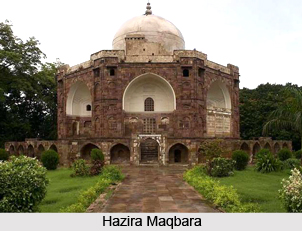 Hazira Maqbara is an ancient mausoleum involving the tombs of Qutb-ud-din-Muhammad Khan, who was the teacher of Akbar`s son Salim. Muhammad Khan was also said to have been the tutor of Naurang Khan, another son of the Mughal emperor Akbar and his tomb is in the city of Vadodara, Gujarat. Naurang Khan supervised important administrative offices in the state of Gujarat under the regime of Akbar. Qutb-ud-din-Muhammad Khan was also the Governor of Gujarat, thrice between 1573 AD and 1583 AD, and he was also Mirza Aziz Koka`s uncle. Koka was Akbar`s foster brother. The final Sultan of Gujarat named Muzaffar II had assassinated Muhammad Khan in the year 1583. Hazira Maqbara has been built following the architectural pattern of the Mughal tombs in the nation and is placed over a high, octagonal platform equipped with smaller gates. It possesses five arches which face the cardinal directions.
Hazira Maqbara is an ancient mausoleum involving the tombs of Qutb-ud-din-Muhammad Khan, who was the teacher of Akbar`s son Salim. Muhammad Khan was also said to have been the tutor of Naurang Khan, another son of the Mughal emperor Akbar and his tomb is in the city of Vadodara, Gujarat. Naurang Khan supervised important administrative offices in the state of Gujarat under the regime of Akbar. Qutb-ud-din-Muhammad Khan was also the Governor of Gujarat, thrice between 1573 AD and 1583 AD, and he was also Mirza Aziz Koka`s uncle. Koka was Akbar`s foster brother. The final Sultan of Gujarat named Muzaffar II had assassinated Muhammad Khan in the year 1583. Hazira Maqbara has been built following the architectural pattern of the Mughal tombs in the nation and is placed over a high, octagonal platform equipped with smaller gates. It possesses five arches which face the cardinal directions.
The actual tomb of Hazira Maqbara is existent inside an underground quarter while the false grave is present in the chamber of the tomb. Beautiful `Jali` work embellishes the eastern walls of the Maqbara and Quranic texts in Arabic language have been artistically carved within the tomb chambers, on the surface of `lintels`. Merlon patterns painted in brick red colour adorns the surface of the parapet walls on the terrace of the tomb structure. Thick layers of plastered brick red colour are present in the lower parts of the cylindrical dome which flanks the tomb. A double-domed structure forms a part of the Hazira Maqbara which also possesses a garden tomb, as well as a stepwell or `Vav` located along the western side of the modern road. This road is currently utilized for supplying water to the garden. The architecture of Hazira Maqbara is inspired by the Safavi-Persian style of architecture and is said to be the oldest amongst the Mughal monuments in the city.
Numerous tombs are present within tinier rooms which can be easily accessed by tourists and worshippers. Inside the Hazira Maqbara is yet another tomb which has been kept in a small room, at a particular odd angle. It is believed that initially the tomb was preserved parallel to the wall, but gradually with the passage of time it moved automatically, without any exterior help.




